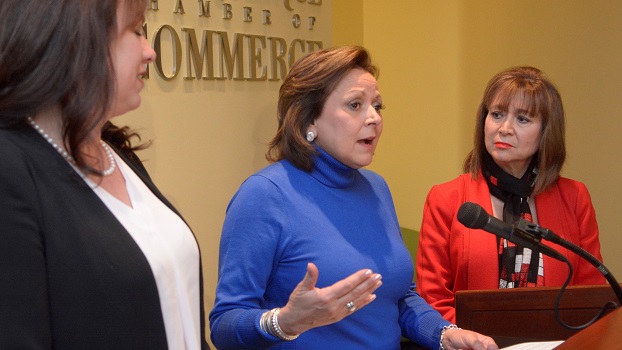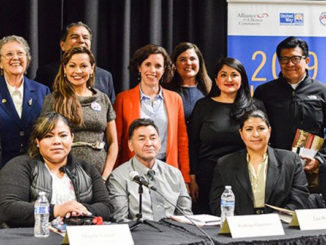
Will Hanna Skandera’s legacy last?
When most people think about aggressive, envelope-pushing education reform, a familiar cast of characters and a familiar set of locales come to mind: Michelle Rhee in Washington, D.C., Paul Pastorek and John White in Louisiana, Tony Bennett in Indiana, Kevin Huffman in Tennessee.
Not many people think of Hanna Skandera in New Mexico. They probably should.
As public education secretary of New Mexico, Hanna Skandera dug in fast, set an ambitious agenda, and broke a lot of china. Her ability to inspire and subsequently ignore controversy is clear: from the outset, she was deemed so contentious that the state senate refused to confirm her for four years, during which she performed her duties as “secretary-designate.” When those same legislators failed to vote on a new teacher-evaluation system, she implemented it via regulation.
In June 2017, Skandera stepped down after seven years on the job, prompting a series of questions about her legacy. Was the Sturm und Drang of the Skandera years worthwhile? Did her later efforts to collaborate with teachers set the stage for sustained progress? And as the next generation takes on leadership roles, what can we learn from Skandera’s challenges and successes? To explore this question, let’s get a more thorough understanding of the New Mexico story—the context surrounding the reforms, the reforms themselves, and what we know so far about their results.

Looking for a Lightning Rod
New Mexico is a state that appears ripe for education reform. It is persistently at the bottom of most national rankings for academic performance and students’ well-being, and faces daunting challenges: nearly three quarters of students are from low-income families and some 16 percent have limited English language proficiency. Statewide, more than three quarters of 4th graders read below grade level, the same share of 8th graders are below grade level in math, and nearly one third of high-school students drop out. In the most recent Quality Counts rankings, New Mexico was ranked last in the “chance for success” category and rated 49 out of 51 overall. Some 61 percent of students are Hispanic, 24 percent are white, and 10 percent are Native American.
Given these statistics, one would think that bringing in a superintendent with a desire to shake things up might be welcomed. It was not.
Skandera’s time in New Mexico began with the 2010 election of Governor Susana Martinez, a Republi-can whose campaign promises included turning around failing public schools. Her victory was groundbreaking in several ways: not only was Martinez the first female governor in the state’s history (and the first Hispanic female governor in the United States), but her election also delivered the governor’s mansion to the mainstream GOP after years of Democratic (or libertarian-leaning Republican) control.
Martinez immediately moved to shake up the state’s public schools, nominating Skandera to lead the Public Education Department. Skandera was best known as a former deputy education commissioner in Florida under Governor Jeb Bush, who had been pursuing a high-profile, accountability-focused agenda of education reforms. Both of New Mexico’s teachers unions and leaders in the Democratic-controlled state senate were openly critical of the pick.
Skandera had never worked as a teacher or school leader, so to subvert her nomination, senate Democrats argued that her appointment would be unconstitutional. The Constitution of the State of New Mexico declares that the state department of education shall be “headed by a secretary of public education who is a qualified, experienced educator.” Since Skandera had never taught, they claimed, she did not meet the criteria.
Neither Skandera nor Martinez relented, however. With Martinez’s support, Skandera simply performed her job without her title until opposition finally wore down. She was at last confirmed as secretary in 2015 on a 22–19 vote, with five Democrats voting in her favor.
As her critics suspected, Skandera adopted a Florida-style approach to New Mexico, pushing forward most major elements of the Bush approach, with the exception of vouchers and tax credits for private schools.
Starting in 2012, New Mexico issued annual A–F letter grades of schools based in large part on standardized test scores. The state also invested substantial support for early readers and focused on retaining 3rd graders who fail to read at grade level; state law allows for, but does not require, those students to be held back, which both Skandera and Martinez criticized as insufficient in a state with exceptionally low rates of adult literacy. And with ongoing implementation of Common Core standards and assessments, Skandera pursued what she calls “truth telling,” or being honest about school and student performance after too many years of failing to acknowledge a painful reality.
In an interview, Skandera said that at its heart, her strategy was to create a shift in mindset, from a “belief that children from poverty can’t learn to a belief that children from poverty can learn.”
That’s not how everyone saw it, however. Ellen Bernstein, president of the Albuquerque Teachers Federation, summarized the Skandera era as “flunking kids, flunking teachers, and flunking schools.”
Getting Tough on Teacher Evaluations
Martinez and Skandera’s top priority was teacher-evaluation reform—described as “number 1A with a bullet” by Paul Gessing of the Rio Grande Foundation, a New Mexico–based free-market think tank. Their efforts were part of an unprecedented wave of teacher-evaluation reforms nationwide, propelled in part by the federal Race to the Top grant program. But the New Mexico system is different in two critical ways from other states’ efforts: its design and launch have been especially mired in political and legal challenges, and its implementation and application have been especially effective at differentiating teachers by the skillfulness of their work.
The evaluation overhaul began with a singular move by Martinez. Three months after assuming the governorship in 2011, she issued an executive order creating the Effective Teaching Task Force, to identify, recruit, reward, and retain high-performing teachers in the state. The 14-member panel, which included Skandera, recommended a new teacher-evaluation system that weighted 50 percent of a teacher’s evaluation on student test scores. A bill to create such a system was passed by the New Mexico House of Representatives in February 2012, but then stalled in the Democratic-controlled senate.
In a controversial move, Martinez directed Skandera’s Public Education Department to implement the system via regulation, starting in April 2012. The state collected baseline data in the 2012–13 school year and fully implemented the new evaluations in the 2013–14 school year.
The new NMTEACH Educator Effectiveness system initially based 50 percent of a teacher’s rating on her “value-added” to her students’ test scores, 25 percent on classroom observations, and another 25 percent on locally determined metrics, such as attendance. (The weights are adjusted for teachers in subjects not covered by statewide assessments or end-of-course exams and for those with fewer than three years of student-achievement data.) The share awarded to value-added was the largest of any evaluation system in the nation, and at the top end of what the Bill & Melinda Gates Foundation’s Measures of Effective Teaching (MET) Project research had recommended.
The power of that approach was amplified by another school-improvement effort: Skandera’s department had also been reworking the state’s end-of-course exams and early-grade assessments, as part of its efforts to implement Common Core standards. These new tests allowed New Mexico to calculate value-added scores for a greater share of its teachers than any other state. Whereas many states lump large groups of teachers together because they do not teach students in tested subjects and therefore receive similar scores based on school-wide averages, New Mexico was able to parse out their individual contributions.
Teachers unions and reform critics complained loudly about the accuracy of value-added data, and almost as quickly as the system was brought online, it was buried in lawsuits. One, filed by National Education Association-New Mexico in 2014, argued that it subverted local control of education. The most substantial lawsuit, filed in 2014 by the American Federation of Teachers New Mexico, argued that implementing test-based teacher evaluations violated state law because they could result in the termination of state employees by executive fiat. Neither case has been resolved, and a 2015 injunction has prohibited New Mexico from using NMTEACH evaluations to make decisions about pay and tenure in the interim. That suit was scheduled to go to trial this past summer, but was delayed again.
Nonetheless, insofar as teacher-evaluation programs are judged by their ability to meaningfully differentiate between the performance of different teachers, New Mexico’s system is a success. Whereas even Florida’s much-vaunted teacher-evaluation system rated 98 percent of teachers as effective or highly effective, the most recent results from the New Mexico system rated only 71 percent of teachers effective or better. Education Week referred to the program as the “toughest in the nation,” and in a study of 24 states, researchers Matthew Kraft and Allison Gilmour demonstrated that it rated 28.7 percent of teachers ineffective—more than twice as many as the next closest state in the nation, Oregon. Elizabeth Ross, managing director of state policy for the National Council on Teacher Quality (NCTQ), refers to New Mexico as a “strong positive outlier” on the teacher-evaluation front.
New Mexico’s system also drew fire for its use of teacher attendance as an additional performance measure, another step that widened the spread of ratings among teachers. Initially, teachers who missed more than three days of work were penalized in their evaluation; this has since been changed to six days. Since the evaluations were introduced, absenteeism has plummeted. Before evaluations, data from the federal Office for Civil Rights reported that 47 percent of New Mexico teachers were chronically absent, missing 10 days or more of school in a year. Today, according to the New Mexico Public Education Department, it is down to 12 percent.
Those rules prompted still another lawsuit, which was filed in early 2017 by a teacher claiming that contractually guaranteed sick leave is private property. The state’s constitution stipulates that private property cannot be taken for public use without “just compensation,” and the suit asks for damages for all teachers “for the value of their earned leave that they were deprived of.”
Looking at a Legacy
What effects have these many changes had on student performance in New Mexico so far? In high school, students are doing better. During Skandera’s tenure, the four-year graduation rate went up from 67 percent in 2010 to 71 percent in 2016. More students are taking and passing AP exams: the number of test-takers grew from 7,636 in 2010 to 10,756 in 2016, and the number of students passing the tests increased from 5,266 in 2010 to 6,440 in 2016.
On other metrics, though, the results are less clear. New Mexico’s scores on the National Assessment for Educational Progress (NAEP) stayed essentially flat from 2009 to 2015, a period when scores nationwide also stalled.
Looking at annual PARCC tests, student performance improved slightly statewide, though pass rates remained very low. The average pass rate in reading grew 2 percent, to 29 percent overall. In math, the pass rate increased by 2 percent, to 20 percent.
But stepping back from court cases and assessment results, perhaps the most important question of education reform remains: is it sustainable? When Skandera stepped down in June 2017 after seven years on the job, Martinez lauded her for being “relentlessly committed to helping us fight the status quo—like teachers unions and other entrenched special interests—to reform education and give our students, teachers, parents and schools more of what they need to succeed.” Will those efforts continue in her absence?
For now, the answer appears to be yes. Martinez appointed Skandera’s former deputy, Christopher Ruszkowski, to succeed her (and, like Skandera, he is doing so as secretary-designate, without being confirmed by the legislature). He has committed to continuing her major reforms.
However, there is a gubernatorial election in 2018, and term limits prevent Martinez from running for reelection. A Democratic governor could turn everything upside down—and in the 2016 presidential election, Hillary Clinton won New Mexico by eight points.
Regardless of who wins the governorship, criticism of the reforms comes from both the right and the left. For example, regarding the A–F school-grading system, those on the free-market right argue it is still “not transparent, not simple, and not easy to understand.” What’s more, Gessing of the Rio Grande Foundation believes “the bureaucracy was not ready” for its implementation, and a policy that is so complicated to implement can’t be rushed.
He also believes that the gung-ho nature of the reforms had negative consequences. “They erred on the side of ‘my way or the highway,’” which resulted in “potential allies turned into foes,” he said. On that, union leaders agree. “Over seven years, they created an under-supported, underfunded, demoralized education system,” said Bernstein of the Albuquerque Teachers Federation.
Both Gessing and Bernstein believe that the next governor will unwind many of the Martinez-Skandera policies. In an interview, Ruszkowski was more sanguine, for several reasons.
First, Skandera did eventually take steps to build support for reform at the ground level, having recognized—to a degree—that criticisms of the speed and fervor of her reform platform had some merit. Her communications strategy was key: she worked with Teach Plus New Mexico, a teacher-leadership group, to communicate with teachers across the state. (Early attempts to communicate with teachers, principals, and parents through local superintendents had amounted to playing an error-prone game of “telephone.”) She also instituted a teacher advisory board, a parent advisory board, a teacher liaison in her office, an annual teacher summit, and a six-month listening tour of schools. Among the fruits of those efforts was an update to the component weighting in the teacher-evaluation system, which now caps value-added at 35 percent and weights classroom observations at 40 percent.
Elizabeth Ross of NCTQ is optimistic about the impact of these efforts. She argues that while the system is “not yet perfect,” Skandera’s and now Ruszkowski’s engagement with individual teachers and networks like Teach Plus “deserves to be celebrated.” Indeed, Skandera and Ruszkowski have started to highlight those efforts, in the form of a coauthored paper on investing in teacher leadership published in December by Chiefs for Change, a group of reform-minded state and district leaders of which Skandera is a longtime member. The starting point: “After many years of education reform, top-down change in public education has become a relic of the past.”
Second, with respect to the lawsuits, Ruszkowski believes that the teacher-evaluation system will be tied up in courts for an extended period of time, allowing his department time to continue implementing, tweaking, and improving it. Rarely in education issues as complex as teacher evaluation do courts issue bright-line, black-or-white rulings; rather, as Ruszkowski put it, “we are continuing to implement this year over year knowing that the courts will have to work it out.” He believes the court will look favorably on the department’s continuous efforts to compromise and that a resolution will likely involve working with the court over time.
Third, Ruszkowski has a couple of political aces up his sleeve. Whereas Skandera’s pedigree included stints working under Republican governors—in California under Governor Arnold Schwarzenegger and in Florida with Governor Bush—Ruszkowski came to New Mexico from working under Delaware’s Governor Jack Markell, a Democrat. He cites Prudence Carter, who codirects the Stanford Center for Opportunity Policy in Education with progressive icon Linda Darling-Hammond, as a mentor of his while he was at Stanford. And he is open about the fact that he approaches the issues from a more left-leaning perspective, something that might come in handy after the next election.
Ultimately, though, he said that whoever assumes the governorship “is going to have to look back on the last eight years and ask if they want to go forward or go backward.” Ruszkowski’s money is on forward.
A Second Wave of Reformers
There is good reason to believe that there will be fewer Hanna Skanderas in the future.
Few of the hard-charging, boldfaced-name education reformers of recent years are still in the positions that made them famous (or infamous). Michelle Rhee left Washington, D.C., after a contentious mayoral election ousted her champion, Adrian Fenty. Indiana’s Tony Bennett is no longer a state superintendent, nor is Tennessee’s Kevin Huffman. Louisiana’s Paul Pastorek is gone. And the next wave of leaders is unlikely to look the same.
There are several forces at play, such as a fissure on the right side of the political aisle, between those who see school choice as the primary mechanism for advancing education improvement and those who want to use school- and teacher-accountability systems to achieve those ends. With the ascendance of Betsy DeVos and the passage of school-choice legislation in dozens of states around the country, for the time being at least, it appears that the school choice–first crowd has the upper hand.
It is also true that the come-hell-or-high-water approach of some reformers carries downside risks, which can outweigh the benefits of the policies they espouse. Sure, if the legislature doesn’t want to support your preferred reform, you can try to have the governor implement it unilaterally or go it alone via whatever regulatory power you may have. But then your opponent can switch the playing field as well, and move the debate into the courts. Even if the opposition doesn’t win a lawsuit outright, they can stall and undermine your reforms until they’ve won the war of attrition.
Teacher-evaluation reforms are less popular now than they were in 2010. According to the most recent Education Next survey, from 2010 to the present support for merit pay for teachers has dropped from 67 percent to 56 percent. Tenure is actually more popular today, with 40 percent support compared to 35 percent in 2010 (“The 2017 EdNext Poll on School Reform,” features, Winter 2018).
But perhaps most substantially, there is a growing awareness in the world of education reform that the big battles over getting new teacher-evaluation laws passed or school accountability systems implemented are not the end of the story (“The Teacher Evaluation Revamp, In Hindsight,” features, Spring 2017). Pace Churchill: they were not even the beginning of the end, but they are, perhaps, the end of the beginning.
These new systems are supposed to set the foundation so that teachers can have better information about how they are doing and can improve their practice. They are supposed to empower school leaders to improve instruction in their buildings. They must not be an end in themselves. When advocacy organizations lose interest after the first battle is “won,” reform-minded superintendents are left to twist in the wind. As Skandera said of the education-reform superintendents of her time, “very rarely did we see them get beyond the fight to what matters most.” Who wants that as their legacy?
But maybe a legacy changes when it is shared. In states and cities with leaders who built a bench, leaders had successors that continued reforms without starting as many fistfights, and reforms have continued to the benefit of students. And with the appointment of Ruszkowski and his seeming commitment to the same agenda, there is a chance that momentum will sustain New Mexico’s reforms. We’ve seen succession work even when local politics change dramatically, such as in Louisiana under John White or in Washington, D.C., where Kaya Henderson preserved much of Michelle Rhee’s agenda, including her path-breaking teacher evaluation system (“A Lasting Impact,” research, Fall 2017).
A court victory in the teacher-evaluation case would clear the decks for even more thoroughgoing reforms of teacher preparation and support of the kind that Ruszkowski has indicated he is interested in pursuing. Perhaps Skandera took most of the heat that opponents have, and like those other second-wave leaders, he will be able to see these projects through. No matter what, the New Mexico reform story continues.
Michael Q. McShane is director of national research at EdChoice.



